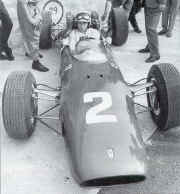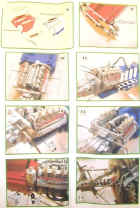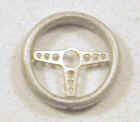|
In response to the domination of the British V-8s in 1962, Ferrari introduced their Aero 156 for the 1963 Formula 1 season. The 156 was originally intended to be fitted with the new 90 degree V-8 engine. However, due to development and production delays, the 156 was powered by a 120 degree V-6. The 1963 season was not a major success for the 156 and once again the British cars dominated. The Ferrari Aero 158 of the 1964 season did receive the new V-8 and carried John Surtees to a very closely contested world championship.
|

|
|
The model
Positive reviews of the 1/24 Bugatti kits mastered by Christian Gouel prompted me to order the CG Models Ferrari 158 from Merrymeet Models. Not being too sure what I to expect when the kit arrived, I was a somewhat surprised at the small size of the box. However, I was very pleased upon opening the well-packed box because it contains a lot of model.
The kit instruction sheet consists of five pages of color illustrations, similar to those provided in recent Tameo instructions, and very clear photographs of the various subassemblies. Painting colors are called out for all the parts in the various steps, but no cross-reference is given to a brand of paint. Other manufacturers would serve their customers well by studying and copying the CG Models instructions. I would suggest, however, that in future kits a proper decal placement/painting guide be included. As such, decal placement is shown on the various assembly photos. Normally, this wouldn't present much of a problem, but because two vastly different paint schemes are provided in the kit, a sheet showing both paint schemes would be handy and practical.
|

|

|
The major kit components consist of five resin, four rubber, 73 white metal, 28 bright plated metal, and 16 turned metal parts. Also included are four springs, various lengths and diameter of wire and nylon, a decal sheet, preformed wire mesh intake covers, two photo-etch sheets, and one clear vacuform. The resin used is a very similar to the resin in Teneriv kits and will benefit from a quick dip in acetone to remove the shiny mold release. The white metal parts are exceptionally clean and will require very little clean up before assembly. The high parts count will result in a very detailed model.
The body and monocoque are very well cast. The body shape appears to be accurate and matches photographs closely. The rivets on the monocoque are very crisp and straight, but compared to photographs appear to be a bit too large. I would suggest toning them down with light sanding and when applying the decals use a setting solution to prevent silvering around the rivets. If the builder intends to display the model with the body off, the front radiator and hydraulic reservoirs will need to be built from scratch, as they are not provided in the kit. The engine and transmission are cast in one piece. Numerous white metal and photo-etch parts are added to the engine casting to represent the pulleys and plumbing. A nice touch is the inclusion of a rubber fuel injection belt and the turned velocity stacks. The basic engine wiring is provided, but
super-detailers will need a good photograph of the engine to add the extra wiring.
|
The suspension parts are plated white metal. I have seen plated metal parts in other kits and have been less than impressed. However, the plated parts in this kit are of outstanding quality. This is due in part to the high quality of the underlying metal castings. There are virtually no visible seams on the parts resulting in a beautiful plated finish. The plated finish is brittle, however, and will require careful removal from the sprue. The wheels are made up of turned rims with white metal and photoetched spokes.
|

|
The shocks are made up of a spring sandwiched between a turned body and a white metal lower attachment point. The two photo-etched sheets are nicely double etched and include several suspension attachment points and the three piece brake discs. The steering wheel is made up of a photo-etched center cast into a white metal rim. This one piece sums up the quality of this kit.
The two paint schemes provided couldn't be more different and only represent cars driven by Surtees. The first scheme builds the red with light blue wheels number seven car as driven at the Nurburgring in 1964. The second scheme is the two-tone white and blue car entered by the North American Racing Team at Watkins Glen and Mexico. The decals are very well printed by Virages. Especially nice is the side body numbers provided as two pieces, eliminating the need to cut the numbers to fit the upper body.
Conclusion
CG Models have far surpassed my expectations with this kit. The level of detail is stunning and it is apparent a lot of thought went into the design of the model. With a little extra effort, the model could be displayed with the body off, but even built as presented, it will be the centerpiece of any 1/24 collection.
|